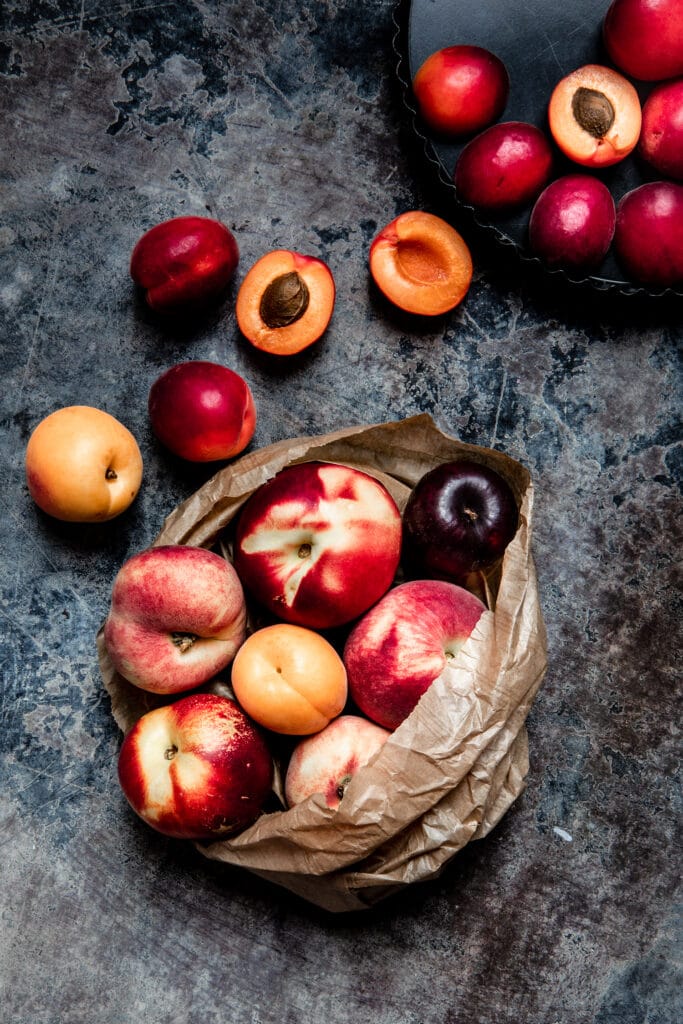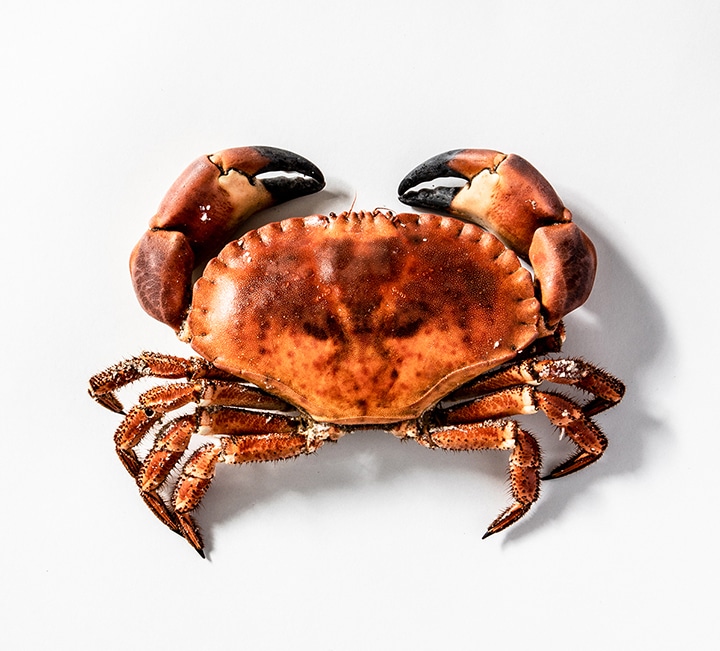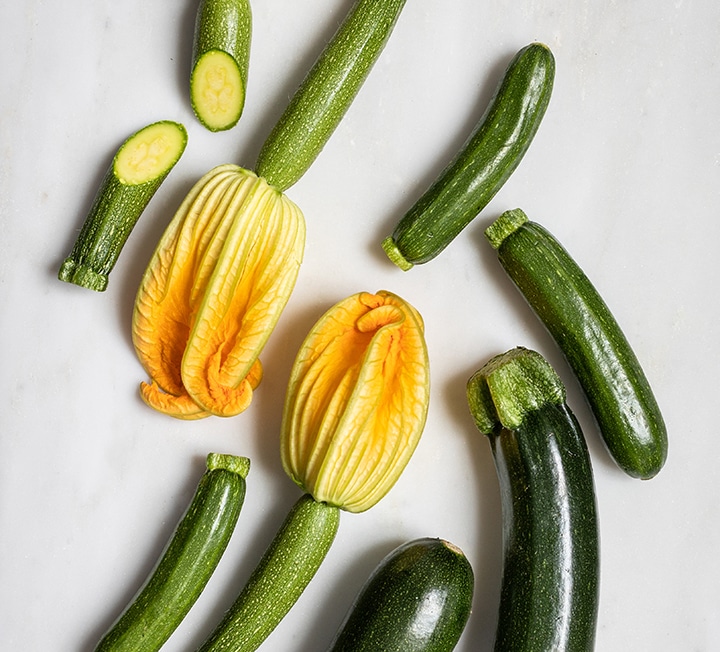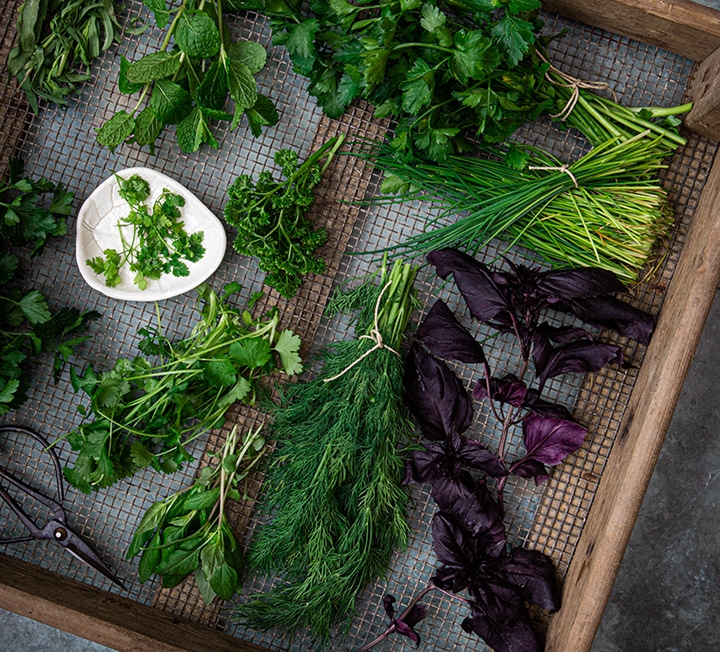The family stone
Rosie Birkett on the joyful memories and recipe ideas sparked by the arrival each summer of stone fruits


“THERE’S SOMETHING OUTRAGEOUSLY, ALMOST ILLICITLY GOOD ABOUT A WARM, FLESHY MOUTHFUL OF PEACH”
Images: Regula Ysewijn
A bag of ripe peaches heralds the summer. It summons flashbacks to moments suspended in time like peaches preserved in syrup: soporific garden lunches with bowls of peaches and cream; a lone, slightly squashed orb wrapped in kitchen roll at the bottom of my schoolbag – a sweet, longed-for, reviving joy after an ascetic hour of dreaded double maths.
I can be on the Walthamstow marshes, surrounded by nettles, fox poo and teenagers playing football and feel like I’m in the south of France if I’m biting into a perfectly plump peach – its honeyed juices dribbling shamelessly down my chin. There’s something outrageously, almost illicitly good about a fleshy mouthful of peach that’s been left to get warm-to-bursting in the sunshine, and if I’m hauling our meals to the park to escape our stifling London apartment in high summer, these make for a blissful dessert, just as they are.
Along with sublimely fragranced white peaches from France and Italy, flat peaches are a favourite. Slightly less fuzzy than their rounder siblings, their headily perfumed, pale flesh has an extra sweet flavour with a whiff of almond. Originally grown in China – where the peach originated – from a mutation of the common peach, they have become popular across Europe in the last few decades, but make sure you look out for the organic, Spanish-grown versions rather than the sad, plastic-wrapped imports from further afield. One of my favourite ways to use them is baking them into a light, almondy upside-down cake with cherries and basil. The soft fruit keeps the cake moist, sort of self-saucing it, while the basil lends a fragrant edge and the flaked almonds an irresistible crunch. With the addition of a luscious spoonful of clotted cream or creme fraiche (Neal’s Yard Dairy, I’m looking at you), it’s everything I want in a cake.

Almonds and peaches are a happy combination much-loved by the Italians, particularly in the classic dish of ‘pesche ripiene’, or stuffed peaches. The version from my battered, browned copy of Elizabeth David’s Italian Food has been a staple at our kitchen table for years. It calls for six yellow peaches, three ounces of crushed macaroons (in the 1950s, this meant amaretti biscuits), one egg yolk, two tablespoons of sugar and an ounce of butter. You cut the peaches in half, scoop out the stones and mix a little of the pulp with the other ingredients, then stuff it back into the peach, baking them in a buttered dish for around half an hour. I’ve made several versions over the years, replacing the amaretti with flaked almonds or the egg yolk with more butter, and (sorry Elizabeth) adding a splash of sweet white wine, prosecco or rosé to proceedings when the mood’s taken me.
If you’ve not tried before, have a go at pickling peaches. When left to bathe in a sweet solution of good quality white wine vinegar, sugar, fennel seeds and peppercorns (or whichever aromatics you might fancy), they take on an incredible complexity and depth of flavour, and a balanced acidity that makes a wonderful accompaniment for fatty, grilled, meaty things like pork chops or great hunks of hard, nutty cheese such as comte or manchego. The skins will wrinkle with time but don’t worry about that – you can just peel them off.
In a similar vein, peaches are marvellous in substantial salads. I love them paired with the peppery, slightly citrussy flavour of celery leaves, tossed with a sharp goat’s curd, sourdough croutons and prosciutto and strewn with anise herbs like chervil or tarragon. At a late-summer supperclub a few years ago, I served a version of this with Cornish pork belly that had been slow braised in whey and then crisped up under a hot grill. There’s something magical about crispy pork crackling eaten with yielding peachy flesh.
Apricots, with their smooth, deep golden skins blushing hot pink, are another wonder of the warmer months. If the flesh is mealy and the flavour one-note, they can underwhelm – but even these can be rescued with a gentle roasting in the oven or caramelising in the pan, or by poaching in a wine-based syrup. I like to poach whole apricots in sweetened rosé with lemon zest and fresh lavender – the floral, herbaceous notes of the purple flowers add a pleasing complexity, and the poaching concentrates the flavour. I use these in all manner of desserts: baked into tarts, or eaten with whipped cream cut with a little natural yoghurt and topped with crushed shortbread and chopped nuts.
Very good apricots have a unique sharpness that makes them ideal for patisserie. Paired with sweet, vivid green pistachio frangipane, they really sing. I’ve made various ensembles, from blondies to more classical tarts with flaky, buttery pastry. My absolute favourite, though, is to bake them into a biscuity, hazelnut pastry tart shell with a sharp, muscovado-laced buttermilk filling that retains an irresistible wobble once baked, dressing the fruit with tangy, silky custard upon slicing.
Growing up in Kent, plums were the fruit that defined the late summers of my childhood. I still remember my unexpected delight at biting into the dusky reddish-purple skin of my dad’s homegrown plums to find something juicy, sweet and sharp – better than anything I could have bought from the school tuck shop (and that’s saying something, for I was its best customer, loading up on Wham bars and pink shrimps daily – it’s a miracle I’ve still got teeth). In recent years, I’ve become partial to greengages, enjoying their fresh, tangy flesh in dairy-rich desserts and salads with peppery leaves, or in my favourite breakfast compote, made with whole almonds or cobnuts, ideal on hot buttered crumpets or mounds of good yoghurt.
Small wild plums, similar to mirabelles, grow copiously on the marshes where I live. I’ve roasted pork on top of them so that its juices mingle with their blistered skins. I’ve even had a go at salt-fermenting some, inspired by the Japanese delicacy of umeboshi. The resulting shrivelled, concentrated, wonderfully sour fruits were a revelation, so I served them in a dashi-like broth at my residency at Carousel in Marylebone, which I had the unplanned audacity to dish up to some real life Japanese people, visiting from Tokyo. Thankfully, they approved of my approximation – or else were just too polite to let on.


